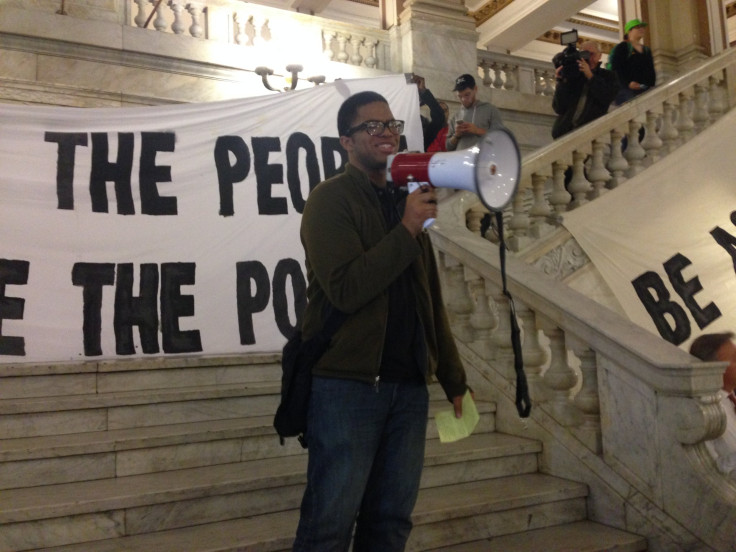Was Ferguson October A Success?

ST. LOUIS -- “Who’s ready to take a walk?” Kennard Williams shouts through a megaphone to a few dozen protesters gathered at the Soldier’s Memorial here. It is one of the smaller crowds organized as part of Ferguson October, the name given to a number of demonstrations held over the long weekend in response to the police-involved shootings of Mike Brown and Vonderrit Myers, Jr. -- but the small turnout is by design.
Williams is one of the leaders of the St. Louis-based Missourians Organized for Reform and Empowerment, or MORE. The protest on Monday afternoon was among at least four held simultaneously -- all of them not announced on the Ferguson October website, the go-to resource for the thousands who came to St. Louis and Ferguson to participate in the events. “We didn’t want any undue presence,” Williams said of why his protest wasn’t publicly announced, referring to the police.
The small protest differed from the large crowds that gathered throughout the weekend. Not only was Monday afternoon’s demonstration smaller in number, but the event went beyond the chanting of “No Justice No Peace” and “Hands Up Don’t Shoot.” Williams led the group to St. Louis City Hall, where participants tied banners to staircases inside that read “Be Accountable Or Be Gone,” “We Are The People We Have The Power” and “Which Side Are You On.”
Once most of the crowd was inside, Williams rattled off a list of demands he wanted addressed by St. Louis Mayor Francis Slay: body cameras for police involved in public interactions; a civilian review board to provide oversight for police; an independent investigation into the death of Myers, the black teen who was shot in St. Louis’ Shaw neighborhood last week by a white off-duty police officer; and St. Louis’ removal from the so-called 1033 program that lets local governments receive tanks and tactical military gear from the federal government for free. Williams gave 48 hours for the city to acquiesce to his demands or he threatened “large-scale civil action against City Hall” on Wednesday.
“We’re tired of election officials not being accountable for their actions,” Williams said. “This [protest] will get results because if it doesn’t it shows they don’t want to work with peaceful people.”
Chants of “Where Is Slay?” echoed throughout the building, but Jeff Rainford, the mayor’s chief of staff, said he wasn’t inside. Slay later tweeted that he was undergoing a “minor medical procedure” and responded to the group:
I missed the action at City Hall. Minor medical procedure. I'm fine. (Thanks for asking.) #fgs
- MayorSlay.com (@MayorSlay) October 13, 2014Asked: 1. Civilian review 2. Body cams 3. Independent review 4. 1033 Program #fgs
- MayorSlay.com (@MayorSlay) October 13, 2014We are already working on all of them. And we are not in 1033. #fgs
- MayorSlay.com (@MayorSlay) October 13, 2014Williams led the group out of city hall unsatisfied. “Let’s leave them to the paper pushing,” he said of the city hall employees in the building. “Not the important papers, obviously.”
Still, Williams said the protest wasn’t a failure. “We come here to prove a point,” he said. “I feel like I’ve identified that we’re not afraid to come here.”
Rasheen Aldridge, director of Young Activists United STL, said the work of the events in St. Louis and Ferguson that galvanized thousands of people will not end after Monday. “What happened to Mike Brown was not the beginning and it’s not going to be the end, sadly,” he said. “His blood called for people to come out.”
Those who turned out for Ferguson October called on Ferguson Police Officer Darren Wilson to be indicted. One theory spread throughout the weekend is that the grand jury won’t indict Wilson, and that the decision will be announced during the winter, in hopes the protests that have been waged since the summer will die down due to cold weather.
But the protesters said they are here for the long haul.
“We got snow boots and coats,” said Beverly Jones, a St. Louis resident who showed up to a protest earlier Monday at the Ferguson Police Department, where activist Cornel West and a number of clergy were arrested when they broached a police line at the front of the station. “My car does have a heater in it.”
© Copyright IBTimes 2024. All rights reserved.






















